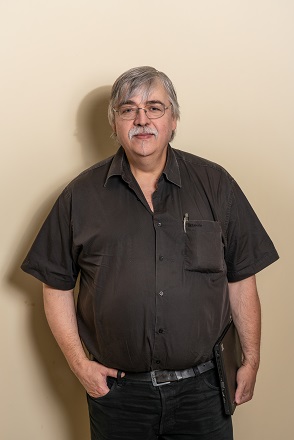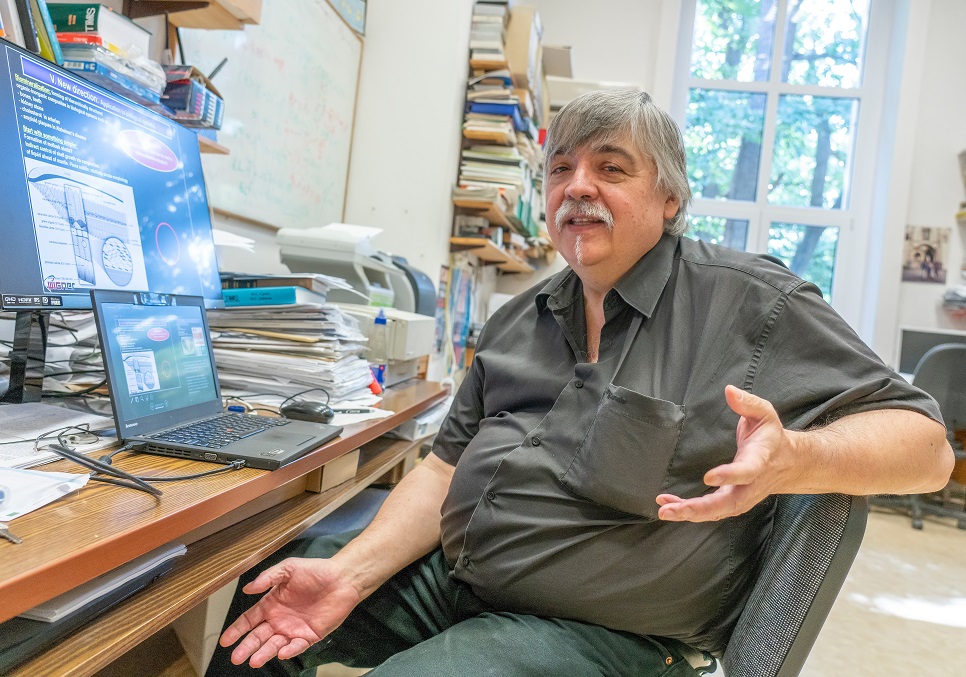Professor László Gránásy and his team are engaged in modelling the formation of polycrystalline materials, a research they were granted funds for early in 2018 under the “Frontline” – Excellence Programme developed by the NRDI Office. The goal, after having fully understood the crystallisation process, is to use the results in biological systems.

Professor László Gránásy
In the “Frontline” – Excellence Programme developed and announced for the first time by the National Research, Development and Innovation Office, 12 research group leaders have won grants of HUF 150 million to 300 million each, of a total budget of HUF 3 billion, to be spent in the coming five years on creating or expanding their research group and implementing discovery research projects promising world-class outputs in Hungary. One of the winning researchers was Professor László Gránásy, scientific advisor at the Wigner Research Centre for Physics of the Hungarian Academy of Sciences.
At first sight, there are only few common features in metal alloys the majority of our tools and devices are made of, ice frost on windowpanes, human bones, mollusc shells and in the so-called amyloid plaques forming in the brain in Alzheimer’s disease. Yet there are some: these are all polycrystalline materials, in other words they are composed of large numbers of crystal grains and in these grains the atoms or molecules are located on a grid that repeats in space.
The physical and chemical characteristics of polycrystalline materials highly depend on the size, the shape and the chemical composition of crystal grains, in other words, on the microstructure. Microstructures created through the solidification of liquids cooled below freezing point (supercooled) are highly diverse. However, even though the polycrystalline materials listed above are composed of molecules of rather diverse geometries, interesting similarities can also be observed on the level of the microstructure: freezing water contains the same pine branch-like dendritic shapes as metals or even crystallising polymers. Similarly, polycrystalline patterns composed of circle- or spherical-shaped needle-like crystal aggregates, called the spherulites are also common.
Due to these similarities, it is likely that these processes can be described on common mathematical grounds. The formation of polycrystalline microstructures is determined by three processes: crystal nucleation: through the random movement of atoms, crystal seeds that are able to grow are formed; crystal growth: occurs at a speed depending on the material and the circumstances; and eventually grain coarsening: larger crystal grains in a polycrystalline material grow at the expense of the smaller ones.
Twenty years already invested
László Gránásy and his colleagues have been studying the formation of polycrystalline materials for a longer time now at the Wigner Research Centre for Physics of the Hungarian Academy of Sciences (HAS). “We have been dealing with the modelling of processes defining the microstructure for nearly twenty years now”, Mr. Gránásy recalls the beginnings. “With about 7-8 years of work we developed an orientation-field-based phase-field model that enables us to handle various mechanisms of crystal nucleation and polycrystalline growth simultaneously, an approach, in which the role of thermal fluctuations is played by the noise added to the equations of motion, represented by random numbers having the right properties. For the first time in history, such complex solidification morphologies could be simulated as the disordered (“dizzy”) dendrites, the crystal sheafs, the spherulites, and the fractal-like polycrystalline aggregate structures. We were also successful in describing the interaction between foreign particles and the crystallisation front, as well as the impacts of scratching or piercing the polymer layers on the crystallisation morphology. Wherever experimental information is available on the orientation distribution, a good parity can be observed between experiment and theory.” Considering all fields of physics, this work was selected one of the 15 most important scientific achievements in 2004 by the editors of the American journal, Science News.
The group works basically on two size scales: the atomic scale (the level of nanometres), where crystal nuclei are formed, and the mesoscale that ranges from one micron to several millimetres. “Combining our model with other physically established methods we managed to model the morphological changes in aluminium-titanium alloys on a surface area of 2 centimetres by 4 millimetres. Obviously, the morphologies received through the simulations show only statistical similarities with the reality as, because of the fluctuations, the same microstructure never forms twice in nature either, that is to say, what happens cannot be predicted in such details”, emphasises Professor Gránásy.
The outputs of their discovery research into model development were successfully used in research projects aimed at developing materials of industrial importance, and through this they participated in numerous application-oriented international projects funded by the European Space Agency (ESA) and the European Union (EU). These research projects were aimed at optimising soft magnetic materials, and developing turbine blade materials tolerating higher temperatures, lead-free self-lubricating bearing materials, and self-organized materials of special optical properties known as metamaterials. Their successes are well illustrated by the fact that their achievements made it to the cover of scientific magazines and journals (the prestigious Nature Materials, among others) nine times in the past one and a half decades.
Universal knowledge?
The question arises as to how universal the accumulated knowledge is, in other words can it be used for other families of materials? An answer to this question is sought by one of their projects launched at the beginning of this year, funded under the “Frontline” – Research Excellence Programme implemented by the National Research, Development and Innovation Office. They are planning to clarify the universality of the knowledge gained on polycrystalline solidification in three areas:
The work planned in the first area aims at understanding crystal nucleation in simple liquids (like metal melts). Here, it is interesting that while the available theoretical descriptions for simple liquids often appear to be in error by orders of magnitude, recent experiments on colloid suspensions have provided detailed information on the process of crystal nucleation, revealing phenomena such as the appearance of disordered, amorphous, yet solid isles prior to nucleation, on the surface of which do the crystal seeds appear. “If the same proves true for metals, then we will have to rewrite everything we thought so far of crystal nucleation in metals”, suggests the researcher.
One of the key characteristics of polycrystalline materials is the change in spatial orientation of crystallites. This inspires the investigations planned in the second research area. Although, earlier, the research group found good correspondences between the theoretical and experimental orientation distributions of spherulites forming in polymer films, only few adequate-quality experimental information was accessible. In the past years, with the improvement of experimental methods, much more detailed surface and volume information has become available for different families of materials. This enables an extensive verification and, and if necessary, further refinement of the orientation-field-based phase-field theories, providing thus an opportunity for the clarification of the universality of the orientation description.
The third and maybe the most exciting, yet the riskiest research direction is the assessment of whether the methods of material physics can be used in biomineralization. During biomineralization, hierarchically structured organic-inorganic composite materials are formed in a biological system. Examples for such processes are the formation of bones, teeth, kidney stones, or crystalline cholesterol in the arteries. They are planning to investigate this topic in close cooperation with the researchers of the Center for Molecular and Cellular Bioengineering of the Technical University of Dresden. First, they are going to start with a relatively simple problem: the mathematical description of the formation of mollusc hells. “There is this very simple organism: the mollusc that develops a rather complex structure: the mollusc shell that is a surprisingly resistant material compared to its thickness and composition. Molluscs influence the microstructure of their shell by changing the composition of a gelatinous layer. To what extent are we able to learn this controlling technique from this simple organism? The long-term objective is to learn how to create light and strong structures organized similarly to mollusc shells from other materials. This can also open the route towards understanding more complex cases of biomineralization.”
The National Research, Development and Innovation Office (NRDI Office) granted nearly HUF 200 million to the research group for this work to be performed between 2018 and 2022. The majority of this amount, roughly HUF 126 million will be spent on HR costs, another HFU 15.5 million on complementing the existing hardware capacities and the remaining amount will cover participations in international conferences, the costs of material purchases and support planned international cooperation projects. “As a matter of fact, we wanted to spend more on HR costs so that we could give a competitive salary to our young researchers. It is actually hard to compete with the enticement of western researcher salaries or even the salaries offered by Hungarian industrial actors. I have already lost, to this latter, one of my researchers.” Nevertheless, work is in progress and they do their best to implement their research outputs in practice.







